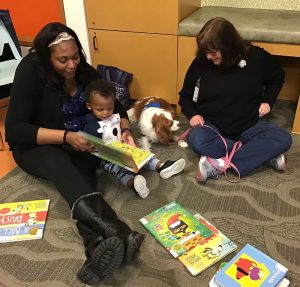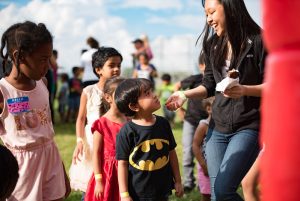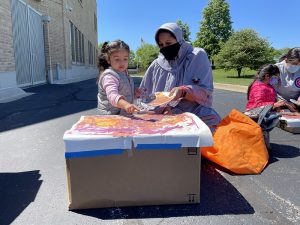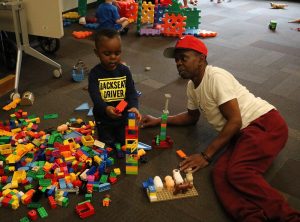Did you know that November is National Family Literacy Month?
As library workers, of course, we want to help your children develop a love of reading. As family members, I assume you do too, or you wouldn’t be reading this post. But did you know that you can help your child develop literacy skills by doing more than just reading books? There are five practices of early literacy that can be incorporated into your day to help your child grow and develop.

Read
Read all the books! Reading together with your child is one of the best ways to help your child develop a love of reading. Of course, picture books are great because the pictures help give context to the words that are being read. But you can also read longer chapter books to your young child. This will expose your child to even more vocabulary words and experiences. It will also help with attention, listening comprehension and is a great way to bond.

Sing
Singing slows down language and breaks words down into syllables, making them easier to understand. It doesn’t even have to be a “real” song. Just add a sing-songy melody to what you are saying to your child. When my children were young, I was very self-conscious about singing, since I am not a strong singer. But a friend once told me something that has stuck with me all these years. She said, “It’s not about how you sound, but the experience and memories you are creating. To your child, you have the best voice in the world. So sing away!”

Talk
Talking helps your child learn new words and increase their vocabulary. This will in turn help them become better readers. Let’s say, for example, you talk about all of the fruits and vegetables you see when you are at the grocery store, and you label them by name and talk about the different qualities of each one. Fast forward several years to when your child is reading a new story in the classroom. When they get to a word like cantaloupe or asparagus, if they had never been exposed to that word before, they might be able to sound the word out but have no idea what the word means. But if they heard you talking about it at the store, the minute they read that word, they will be able to picture it in their head, improving their reading comprehension.

Write
This one is near and dear to me, as I was a Certified Occupational Therapy Assistant for 16 years prior to switching careers and coming to work at the library. When most people think about writing, they probably think about using a pencil on paper to write letters, words and sentences. But writing is so much more than that, especially when we are talking about children ages birth to 5 years old. Just about everything a child does with their bodies from birth is helping them develop skills that they will need to be writers when they get older. Would you believe it if I told you that tummy time is one of the first things you can do to develop the muscles needed for writing? I could write an entire post just on that! I could also go on for days about how kids today are given pencils and are expected to write letters way too early in the developmental process. Scribbling and drawing are the beginning of early writing skills. But there are so many ways you can do this without using a pencil and paper. Use a variety of sensory materials, like shaving cream, finger paints or a tray of rice, and have your child use their fingers to draw lines and shapes.

Play
Playing helps children build their imagination. Children learn problem-solving, cooperation, cause and effect and improve fine and gross motor skills. You don’t have to have expensive toys or an elaborate setup. Just grab whatever you have in the room and follow your child’s lead. You can use old clothes for dress up, blocks or small boxes for building, plastic bowls and utensils for pretend play. As your child is narrating their play, they are learning how to become storytellers.
You might be looking at this thinking, Oh great, now they want me to add FIVE more things into my already stretched thin day. But this doesn’t have to be a huge production. You can combine some of them and do them at the same time! In fact, I’m sure you are already doing some of these things. Now I encourage you to do them with a little bit more intention so you can help boost your child’s development and love of reading.
